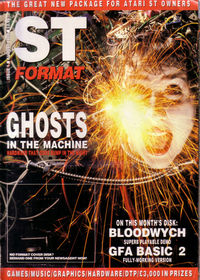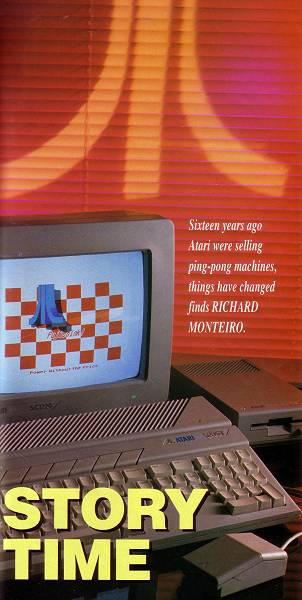
January 1985. The 520ST was launched to stunned
show goers and a disbelieving Commodore at CES
in the States. The ST was displayed seven months
later in the Uk at the PCW show. The Fujiboink demo
you can see displayed on screen was written to
compete against the Amiga's Bouncing Ball demo.
The Atari story starts late in '71 when Nolan Bushnell, then a product engineer for small-time arcade-game manufacturer Nutting, left his job to start his own company Syzygy. The reason: to market the video game Pong. Syzygy, meaning an alignment of celestial bodies, didn't last long because another firm had already registered the name. Atari was subsequently born.

Nolan Bushnell: Atari's founder.
For a few months in 1973 the Pong arcade game was a huge success - it got Atari on its feet. And at the end of that fiscal year Atari clocked $3.2 million in sales. A string of video game hits were produced after that, culminating in a home version of Pong in 1975. At that time Atari was a strange company to work for - there was a frivolity that seemed to match the product line. Employees would walk into the Los Gatos, California, headquarters at any hour of the morning dressed in jeans and T-shirts. This casualness bordering on chaos did the product line no harm. The money kept rolling in.
WARNING SHOTS
Although Atari was successful, it needed big money to go places. And the only way to get that sort of dough was to find a buyer. Bushnell first approached Disney, but after considering the idea his boyhood heroes said no. Warner Communications appeared on the scene and willingly parted with $28 million in August of 1976. Bushnell got half that amount and stayed on as chairman for two years after the takeover. During that time he witnessed the launching of the Video Computer System and 400/800 home computers. Bushnell eventually resigned in early '79 after Warners blamed him for the failure of the VCS machine.
OVERPRICED
Atari's 400 and 800 systems also ran out of steam because they were priced too high. But there was something else: commodore and the Vic 20. Who in their right mind would buy a machine that cost more and offered less? - nobody, as Commodore correctly predicted.
Although Atari hit an all time high with sales in excess of $2 billion in 1982, it soon hit rock bottom in 1983 when the full impact of the Vic and the C64 became apparent. Commodore's success was down to its president, Jack Tramiel, who treated business as war. Commodore's domination, and Atari's demise, would have continued if it wasn't for chairman Irving Gould's disapproval of Jack's intention of putting the Tramiel sons in executive positions throughout Commodore.
JACK THE LAD
Jack said goodbye to Commodore in January 1983 - on Friday the 13th! It was certainly unlucky for Commodore because, over the next few months, much of Commodore top talent left. By this time Warner's Atari was in serious trouble; around $538 million in trouble. Warner approached Jack with a proposition that is still a little hard to believe. The final deal involved Warner selling Atari to Jack and Jack borrowing the money from Warner to buy Atari!
Before Jack took over Atari, someone at Atari commissioned Amiga Inc. (to the tune of $500,000) to work on some exciting new custom chips for future machines. Amiga Inc. became unhappy with the way Atari handled the affair and refunded the money. The developments were sold to Commodore for $20 mil- lion. These developments, of course, eventually turned out to be the Commodore Amiga A1000.
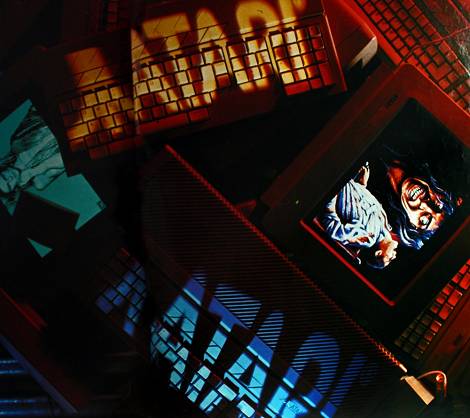
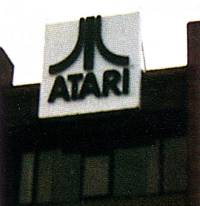
At the University of Utah Nolan Bushnell
learned how to play the ancient
Japanese game Go. While playing the
game, Nolan picked up the phrase 'Atari'
meaning 'watch out or I'm going to get
you on your next move' - a polite warning
to an opponent in peril. Later in life
Bushnell found another use for the term.
The sign (above) adorns the Atari UK
offices in Slough, which is headed by
ex-Commodorian Bob Gleadow.
Naturally these events concerned Atari who, in 1984, hit Commodore with a $100 million lawsuit.
Without wanting to get left behind, Atari started work on its own 68000-based machine. In little more than a year the ST was put together - the important chips in the Amiga, remember, were designed over several years. The ST would never have made it if many of Commodore's key members hadn't joined Atari and many off-the-shelf items like GEM weren't packed into the machine.
The ST was first shown at the January 1985 CES show in the States. The original model was a collection of boxes - the keyboard and processing unit, the disk drive and the power supply. The operating system, TOS, had to be load- ed from disk. Five months later the ST was displayed at the PCW show to an incredulous public. Not long after the show, the ST was available in selected shops. Price for a 512k machine with mono monitor: £749.99.
February '86 saw the addition of a TV modulator to the ST. The machine became known as the 520STM TOS was built into ROM. In March the ST took on the now familiar shape; everything was brought together in one neat box. An F was also added to the title. A 1Mb ST, the 1040, followed shortly after. The Mega ST2 and Mega ST4 were shown for the first time at the September PCW.
In February of '87 the price of the 520 was dropped to £399. September of last year saw the 520 drop a further £100, although for £399 you could get the ST with around £500-woth of free software. That deal is still going today.
Atari has a commitment to further developing the ST range; this is exemplified by the Mega ST1 reviewed over the page.
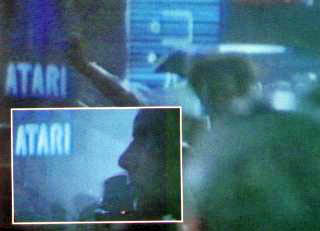
Harrison Ford goes chasing replicates in Blade Runner and
just hap- pens upon an Atari sign in the streets. Any offers
as to how much Atari paid for that subtle bit of advertising?
THINK GLOBALLY
Today Atari's tentacles cover most corners of the globe. Atari France is separate from Atari Germany, Atari Australia is separate from Atari UK, Atari Spain is separate from Atari Canada - each division is treated as an individual organisation.
There are around a million STs throughout the world - that's an impressive figure given that the machine has only recently taken off in a big way. Germany has the largest population of STs by far (between 400,000 and 600,000 depending who you believe). Most of these are 1040s or higher with mono monitors. STs are used as professional tools in Germany which explains why so many serious packages like callous, GFA BASIC and Tempus originate from there.
Like the British, most French ST owners use their machines for entertainment and creativity - the number of games released for the ST over here and in France is ever on the increase, Surprisingly the number of STs in use in both countries is also very similar - around 160,000. In addition to that, there is a 10,000 to 15,000 hardcore of Mega owners over here using their machine for program development and other serious applications like DTP.
In the States the ST hasn't tone tremendously well - the reason, say Atari, is because the machine has never been pushed there. This is due to change over the next few months. Most of the STs in America are used by professional musicians because of the machine's in-built MIDI ports. A vast range of superb MIDI soft- ware from the likes of Dr T also helps.
In countries like Spain and Australia, where the ST has only been in existence for a short while, the number of users is small - 5,000 to 15,000 in each country. The users are mainly hobbyists and their main source of software is PD.
With the ST being such an international beast - and Atari continuing to bring out more powerful versions of the machine - the machine's longevity is assured. And you can expect an international flavour of software for a long time.
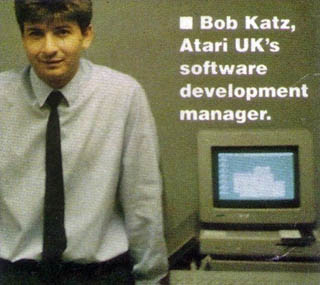
THE FUTURE NOW
The much mentioned laptop ST, Stacy, has been delayed again - possibly by up to three months.
Part of the reason is down to cosmetic changes. There's also the problem of blowing TOS 1.4 on to ROM in time - Atari may have to resort to using more expensive, though quicker to produce, PROMS.
Four versions of the luggable are planned. The basic model will boast TOS 1.4, MHz 68000 processor (identically rated to the current ST processor), 256K ROM, 1Mb of main memory, 32K of static RAM for the screen, Supertwist monochrome LCD screen (with optional backlighting), 3.5-inch double sided floppy drive, trackerball and two mouse but- tons on the keyboard. The liquid crystal display will have a resolution of 640 by 400 - the same as the conventional Atari SM124 monochrome monitor.
The other Stacy machines will have various configurations of drive and memory. For instance, the top end laptop will boast 2Mb of RAM and both floppy and hard drive.
Stacy gets its power in the form of standard batteries whose projected lifespan is anywhere between five and 35 hours. It will be possible to use an external DC supply.
AIl standard ST ports are present on the Stacy: monitor port (for colour or traditional monochrome monitors), serial, MIDI, parallel, floppy, hard disk, RS232, and cartridge.
E BY GAME
ST games players have long been waiting for Atari to produce a machine capable of giving the Amiga a run for its money, It seems an ST compatible computer capable of fulfilling gamers' dreams is just round the corner. The notion of a Super ST, ST Plus, Enhanced ST - call it what you like - has been floated for some time. However, here are the specifications straight from Atari UK's headquarters:
• 4,096-colour palette with one mode being able to display 256 colours and not hog the processor (which Amiga's HAM mode is keen on doing).
• Four-channel stereo sound with frequency and amplitude modulation.
• Extremely rapid multi-directional hardware scrolling.
In all other aspects the STE, as it is to be called, will be identical to the ST. A double-sided floppy will be provided as standard and the processor will be the same 8MHz-rated 68000 affair that graces all current STs. What's really exciting about the STE is that it will be compatible with the ST. In theory anything written for the ST should work on the STE. There's also the matter of price. Atari is looking to incorporate the machine in the Powerpack bundle later in the year at £399! Yes, the same price as the 520.
As this is being written, STEs are rumoured to be heading for developers' desks. What Atari is planning to do is encourage programmers to write programs for the ST and STE simultaneously. The ST code would lie on the top side of the disk and the enhanced STE code on the bottom half. STEs, remember, will come with double-sided drives while many early STs only have single-sided drives.
If all goes according to plan, you could be seeing STEs by the end of the year.
The STE will probably take on the familiar shape of the 520 and 1040; it is unlikely Atari will go for a Mega-style STE.
TT RACING
There is, of course, the TT to look forward to which is being developed in Sunnyvale. The TT will have a 68030 processor, similar graphics capabilities to the ATW and be TOS 1.4 compatible. Essentially you'll be able to run well behaved GEM software. Look out for it next year.

